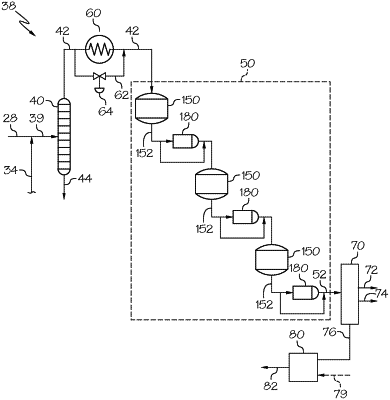| CPC C07C 7/167 (2013.01) [B01D 3/14 (2013.01); B01J 23/62 (2013.01); C07C 5/03 (2013.01); C07C 7/005 (2013.01); C07C 7/04 (2013.01); C07C 2523/62 (2013.01)] | 15 Claims |

|
1. A method for operating an integrated system for producing olefins, the method comprising:
contacting a hydrogenation feed with a first hydrogenation catalyst to produce a hydrogenated effluent, the hydrogenation feed comprising at least a portion of a first process effluent from a first olefin production process and at least a portion of a second process effluent from a second olefin production process, wherein:
the hydrogenation feed comprises at least hydrogen, ethylene, carbon monoxide, acetylene, methyl acetylene, and propadiene;
the first hydrogenation catalyst has a temperature operating range of at least 40 degrees Celsius, the temperature operating range being a difference between a runaway temperature and a cleanup temperature at a given hydrogenation feed composition, wherein the runaway temperature is the temperature at which 3% of ethylene in the hydrogenation feed is reacted and the cleanup temperature is the temperature at which the acetylene concentration in the hydrogenated effluent is equal to a threshold acetylene concentration; and
the hydrogenated effluent comprises methyl acetylene (MA), propadiene (PD), or both; and
contacting at least a portion of the hydrogenated effluent with a second hydrogenation catalyst, wherein the contacting causes hydrogenation of at least a portion of the methyl acetylene, propadiene, or both, from the hydrogenated effluent to produce an MAPD hydrogenated effluent having a reduced concentration of methyl acetylene, propadiene, or both compared to the portion of the hydrogenated effluent prior to contact with the second hydrogenation catalyst.
|